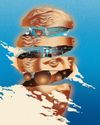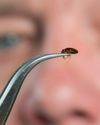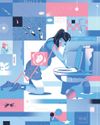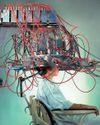
WHAT IS CERN AND WHAT DOES IT DO?
The European Organization for Nuclear Research – known by its French acronym, CERN – is the largest particle physics laboratory in the world. Located just outside of Geneva, Switzerland, it was established in 1954, as one of post-war Europe’s first joint ventures, with the express aim of halting the ‘brain drain’ of talented scientists leaving the continent for America. Today, more than 10,000 scientists hailing from more than 100 countries find themselves at CERN each year to use its facilities, which include some of the biggest and most complex scientific instruments ever created. Their goal: figure out what the universe is made of and the laws of physics that dictate its behaviour.
WHAT DISCOVERIES HAVE BEEN MADE THERE?
Highlights include the 1983 discovery of a pair of elementary particles called the W and Z bosons, which was later awarded the Nobel Prize for Physics. British computer scientist Tim Berners-Lee helped invent the World Wide Web at CERN in 1989 by developing a way for computers to talk to each other, called hypertext transfer protocol (HTTP). In 1995, CERN scientists were the first to create atoms of hydrogen’s antimatter counterpart, antihydrogen. In 2000, they discovered a new state of matter: a hot, dense, particle soup called quark-gluon plasma. And the Higgs boson was observed for the first time in 2012 at CERN’s Large Hadron Collider (LHC), scooping its discoverers a Nobel Prize.
WHAT IS THE LARGE HADRON COLLIDER AND HOW DOES IT WORK?
This story is from the {{IssueName}} edition of {{MagazineName}}.
Start your 7-day Magzter GOLD free trial to access thousands of curated premium stories, and 9,000+ magazines and newspapers.
Already a subscriber ? Sign In
This story is from the {{IssueName}} edition of {{MagazineName}}.
Start your 7-day Magzter GOLD free trial to access thousands of curated premium stories, and 9,000+ magazines and newspapers.
Already a subscriber? Sign In

TAKE IT SLOW
Slow running is a fitness trend with some hard and fast science behind it

Physics, AI and music share a common thread. You just have to know where to look
Studying science can lead you in many directions and open doors to unexpected possibilities along the way

BED BUGS VS THE WORLD
When bloodthirsty bed bugs made headlines for infesting Paris Fashion Week in 2023, it shone a spotlight on a problem that's been making experts itch for decades: the arms race going on between bed bugs and humans

Kids are the key to understanding obesity. But we need more of their genes...
We can unravel the role that bodyweight plays in disease, but we need a bigger, more diverse, sample of genetic material to do so

COVID inquiry: What did we learn and what can we do better in future pandemics?
Masks, social distancing, lockdowns... how effective was the UK's response to the COVID-19 pandemic?

One hormone could be the key that unlocks a cure for morning sickness
The nausea and vomiting that, in extreme cases, can endanger mothers and babies might soon be just a memory

THE WORLD'S WEIRDEST CREATURES
Under the sea and upon the land, some animals look - to us - pretty strange...

WHEN MIND AND MACHINE COLLIDE
First, Elon Musk wanted to make electric cars ubiquitous, then he wanted to make space exploration a private enterprise. Now, with Neuralink, his newest venture, Musk hopes to merge humans and artificial intelligence. Turns out, it might not be such a crazy idea...

COME OUT OF YOUR SHELL
Social anxiety is more than just being shy. It's a phobia born out of our evolutionary past. But that raises a puzzling question: why do so many of us fear human interaction when we're supposed to be the most sociable species on the planet?

SPACE ODDITIES
Take a tour of the weirdest spots in the universe, where the 'normal' rules don't apply. Places that squeeze time, blow bubbles and even rain glass... sideways